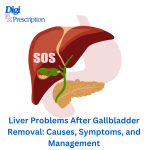
Gallbladder removal (cholecystectomy) is a common procedure to address gallstones, inflammation, or other gallbladder diseases. While the surgery is generally safe, some individuals may experience liver-related issues afterward. Here’s what you need to know about the connection between gallbladder removal and liver health.
Why Liver Problems May Occur After Gallbladder Removal
The gallbladder stores bile produced by the liver and releases it to aid digestion. After removal, bile flows directly from the liver into the small intestine, which can lead to changes in bile dynamics and potential liver strain. Key factors include:
Bile Flow Disruption
Without a gallbladder, bile is less concentrated and flows continuously, potentially causing bile reflux or bile duct irritation.
This can lead to cholestasis (reduced bile flow), increasing liver enzyme levels (e.g., ALT, AST).
Postcholecystectomy Syndrome (PCS)
A small percentage of people develop PCS, which includes symptoms like abdominal pain, bloating, and diarrhea. In rare cases, bile duct injury during surgery can cause liver inflammation or strictures.
Fatty Liver Disease
Gallbladder removal is linked to metabolic changes, such as insulin resistance, which may increase the risk of non-alcoholic fatty liver disease (NAFLD).
Bile Duct Complications
Scarring, leaks, or stones in the bile ducts (post-surgery) can obstruct bile flow, leading to liver damage or infections like cholangitis.
Pre-Existing Liver Conditions
If liver issues (e.g., cirrhosis, hepatitis) existed before surgery, gallbladder removal might exacerbate symptoms.
Common Symptoms of Liver Problems Post-Gallbladder Removal
Jaundice (yellowing of skin/eyes) due to bile buildup.
Upper right abdominal pain radiating to the back or shoulder.
Dark urine and pale stools (signs of cholestasis).
Fatigue, nausea, or unexplained weight loss.
Elevated liver enzymes on blood tests.
Diagnosis and Treatment
Diagnostic Tests
Blood tests: Check liver function (ALT, AST, ALP, bilirubin).
Imaging: Ultrasound, MRI, or CT scan to assess bile ducts and liver structure.
Endoscopic Retrograde Cholangiopancreatography (ERCP): To detect bile duct blockages or leaks.
Management Strategies
Medications:
Ursodeoxycholic acid to improve bile flow.
Antibiotics for infections (e.g., cholangitis).
Dietary Adjustments:
Low-fat diet to reduce bile-related discomfort.
Increase fiber and hydration to support digestion.
Surgical Intervention:
Repair bile duct strictures or remove obstructions.
Lifestyle Changes:
Avoid alcohol and limit processed foods.
Prevention Tips
Follow a balanced, low-fat diet post-surgery.
Monitor liver health regularly if you have risk factors (obesity, diabetes).
Report persistent symptoms (pain, jaundice) to your doctor promptly.
When to Seek Help
Contact a healthcare provider if you experience:
Persistent jaundice or dark urine.
Severe abdominal pain with fever/chills.
Unexplained vomiting or weight loss.
References
Mayo Clinic. (2023). Gallbladder Removal: What to Expect.
Retrieved from https://www.mayoclinic.org
American Liver Foundation. (2023). Bile Duct Diseases.
Retrieved from https://liverfoundation.org
Gallbladder Disease.
Retrieved from https://www.niddk.nih.gov
Cleveland Clinic. (2023). Postcholecystectomy Syndrome.
Retrieved from https://my.clevelandclinic.org
Healthline. (2023). Liver Problems After Gallbladder Surgery.
Retrieved from https://www.healthline.com
Journal of Hepatology. (2022). Metabolic Impact of Cholecystectomy.
Disclaimer: This information is for educational purposes and not a substitute for medical advice. Consult a healthcare provider for personalized guidance.
